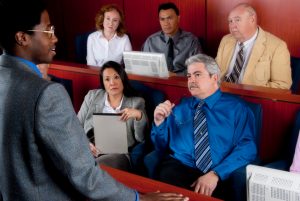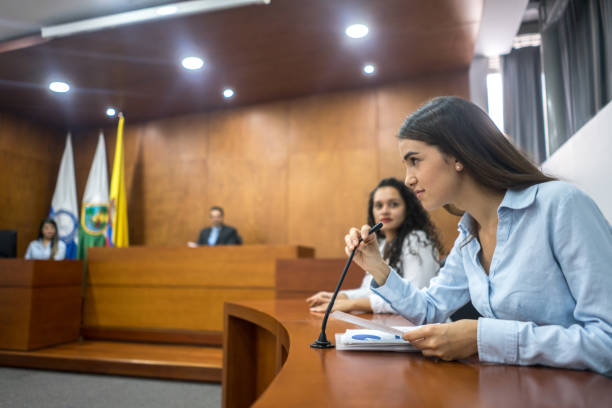From Idea to Courtroom: Actions to Produce Effective and Convincing Trial Presentations
From Idea to Courtroom: Actions to Produce Effective and Convincing Trial Presentations
Blog Article
Navigating the Intricacies of Trial Presentations: Tips for Seamless Delivery and Compelling Arguments
In the world of lawful process, the art of trial discussion stands as a crucial component of success. The complexities inherent in trial presentations need a delicate equilibrium of skill, skill, and strategy.

Understanding Test Objectives
To effectively navigate a trial, it is critical to have a clear understanding of the goals that require to be accomplished. Before tipping right into the court, legal teams must define their objectives and wanted results. These objectives function as leading concepts throughout the test, forming techniques and influencing decision-making procedures.
Comprehending test purposes entails a detailed analysis of the instance, legal precedents, and the client's ideal interests. Trial Presentations. It needs a meticulous exam of the truths, recognizing essential problems, and preparing for potential challenges. By establishing details and measurable goals, lawyers can tailor their presentations and debates to line up with the wanted results
In addition, a clear understanding of test purposes enables lawful groups to focus on evidence, witnesses, and legal arguments successfully. It enables for the development of a systematic narrative that reverberates with the discretionary, enhancing the total situation presentation.

Organizing Evidence Successfully
Having a clear understanding of trial objectives lays the foundation for organizing proof effectively in legal proceedings - Trial Presentations. By straightening the presentation of evidence with the wanted results of the test, legal teams can reinforce their disagreements and enhance their persuasiveness. One critical aspect of arranging evidence is categorization. Organizing evidence based on motifs or significance to details legal aspects can assist improve the discussion and make complicated info much more digestible for the judge or jury.
One more secret element in organizing proof successfully is establishing a logical flow. Offering evidence in a consecutive and systematic fashion can help develop an engaging narrative that sustains the lawful debates being made. Additionally, utilizing visual help such as timelines, graphes, or graphs can additionally improve the organization of proof and assist in clearing up complicated partnerships or sequences of occasions.
Moreover, making certain that all proof offered is permissible and pertinent to the situation is essential. Unimportant or inadmissible proof can interfere with the strength of the argument and potentially damage the reputation of the offering celebration. As a result, a precise testimonial and choice process need to be carried out to include only one of the most legally audio and impactful evidence in the test discussion.
Crafting Persuasive Narratives
Crafting compelling narratives plays a crucial duty in providing persuasive debates throughout legal procedures. When building a story for a test discussion, it is necessary to establish a clear storyline that my link highlights essential points and connects them in a systematic way. By weaving with each other proof, statement, and lawful arguments right into a influential and natural story, legal specialists can successfully promote for their clients and increase the likelihood of a favorable end result in the courtroom.
Mastering Aesthetic Aids
Reliable use of aesthetic aids is vital to improving the influence and quality of trial discussions. Aesthetic help, when made use of tactically, have the power to simplify complex info, reinforce bottom lines, and leave a lasting perception on the discretionary. To grasp aesthetic aids in test presentations, it is important to ensure that they are clear, succinct, and relevant to the debates being made.
When integrating visual aids, such as charts, photos, timelines, or charts, into a test presentation, it is important to keep them visually appealing yet expert. The visuals need to enhance the verbal debates, offering a graph of the info being reviewed without overwhelming the target market with unneeded information.
Moreover, exercising with the visual help beforehand is critical to guarantee a seamless shipment during the test. Familiarizing oneself with the material, transitions, and timings of each visual aid can help maintain the circulation of the discussion and avoid technical glitches that might emerge.
Delivering Impactful Closing Arguments
An engaging closing debate works as the culmination of a trial discussion, enveloping the core narrative and convincing the judge and jury towards a positive choice. To supply an impactful closing debate, it is critical to succinctly summarize crucial points, highlight the strengths of your case, and attend to any weaknesses in a tactical manner. Begin by detailing the major disagreements that support your client's position, emphasizing why the evidence offered throughout the trial supports your narrative. It is important to develop a feeling of cohesion and quality, leading the discretionary towards the preferred verdict.
In addition, including Visit This Link psychological charm can additionally enhance your closing argument. Ultimately, a well-crafted closing disagreement need to leave a long lasting impression, compelling the judge and court to rule in your client's favor.
Conclusion
In verdict, mastering trial presentations entails understanding purposes, arranging proof, crafting basics narratives, using visual help, and providing impactful closing disagreements. By executing these methods successfully, attorneys can present their situation flawlessly and make compelling arguments in the court room. It is crucial to navigate the intricacies of trial discussions with accuracy and ability to attain success in legal procedures.
By straightening the discussion of proof with the wanted results of the trial, legal teams can strengthen their disagreements and enhance their persuasiveness (Trial Presentations). To grasp aesthetic aids in test discussions, it is important to ensure that they are clear, succinct, and pertinent to the disagreements being made
A compelling closing debate offers as the conclusion of a trial discussion, enveloping the core story and convincing the judge and court towards a positive decision. Begin by outlining the major disagreements that support your client's placement, stressing why the evidence offered throughout the test sustains your narrative.In final thought, mastering trial presentations involves understanding goals, arranging proof, crafting narratives, using visual aids, and providing impactful closing disagreements.
Report this page